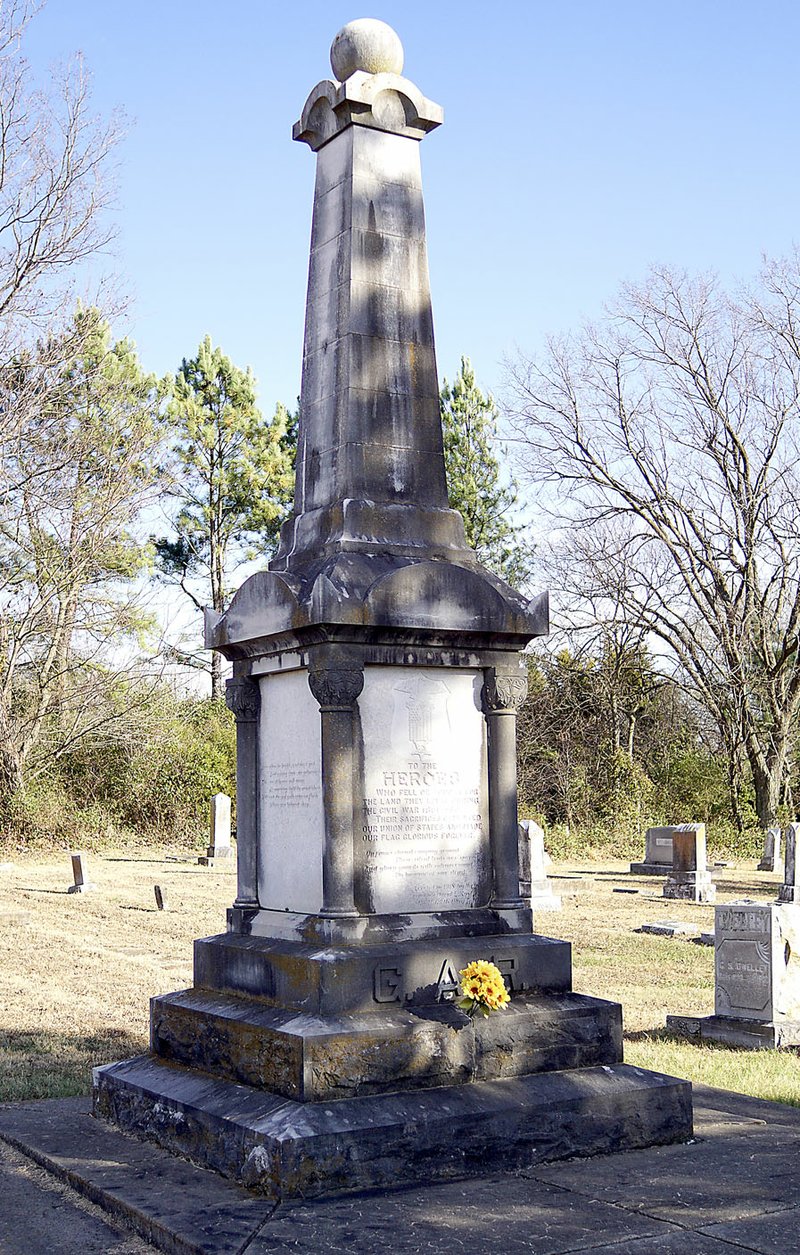GENTRY — A Union soldier monument stands in the northeast section of the Gentry Cemetery on Pioneer Lane, southeast of the Gentry Primary School.
Arkansas has more than 20 Confederate monuments, but fewer people know about the state's four monuments that honor Union soldiers, said Mark Christ, a spokesman for the Arkansas Historic Preservation Program.
Christ said he didn't find out about one of those monuments until just a couple of months ago after reading about it in a back issue of The Benton County Pioneer, a publication of the county's historical society.
The 18-foot-tall monument has been sitting in Gentry Cemetery since 1918.
"One of the best-kept secrets, I guess," said Gentry Mayor Kevin Johnston. "It's quite the monument. It's not the kind of thing you see in every cemetery."
The Preservation Program is considering the monument for nomination to the National Register of Historic Places, where the other three are already listed.
The program's state review board will meet today in Little Rock to discuss the monument and 13 other properties that are being considered. Christ said the program has a 98 percent success rate with the nominations it makes to the National Register.
The Gentry monument was installed by the Grand Army of the Republic, a national organization of Union Civil War veterans that also put monuments in Evergreen Cemetery in Judsonia in 1894 and Siloam Springs' Twin Springs Park in 1928.
Arkansas' fourth Union monument is in Little Rock National Cemetery. It was placed there in 1916 by the state of Minnesota and honors Civil War soldiers from that state who are buried at the cemetery.
The Grand Army of the Republic was initially formed to help the widows and orphans of fallen Union servicemen and to support the Republican Party but later focused on promoting patriotic activities and decorating the graves of the war dead, according to the National Register nomination, which was written by Christ.
The Grand Army of the Republic had at least 123 posts in Arkansas, Christ wrote. Several of them were in Benton County, including posts in Bentonville, Rogers, Springdale, Pea Ridge, Sulphur Springs, Garfield, Gentry, Siloam Springs and Nebo (later Gravette).
The inscription on the Gentry monument reads: "To the heroes who fell or fought for the land they loved during the Civil War, 1861-'65. Their sacrifices cemented our union of states and made our flag glorious forever."
The inscription also includes a few lines of verse, then indicates it was placed there in 1918 by David L. Kost, Company H, 65th Ohio Infantry Regiment.
Kost served a term in the Missouri House of Representatives and two terms in the state Senate before moving to Gentry in 1894, where he bought a farm outside of town and operated a newspaper, according to the nomination.
"David Kost died on July 25, 1925, and was buried in the shadow of the monument he erected in Gentry Cemetery," Christ wrote.
Arkansas has 19 Confederate monuments, three memorials and eight cemeteries (or sections of cemeteries) that are listed on the National Register. That is in addition to the Confederate State Capital in the Hempstead County town of Washington.
Christ said there are other monuments to the Confederacy around Arkansas, including at least two benches and a couple of boulders. The state has a couple of monuments dedicated to those who died on both sides in the Civil War.
Although Arkansas seceded from the Union and fought for the Confederacy, loyalties were largely split between the Delta, which had a slave-based plantation system, and the mountains to the north and west, where farmers engaged in subsistence agriculture, according to the Encyclopedia of Arkansas History and Culture.
"Despite having the third smallest white population of any Confederate state, Arkansas supplied more troops for the Union army than any other Confederate state except Tennessee," according to the encyclopedia article written by Thomas DeBlack, a professor of history at Arkansas Tech University.
Christ said about 60,000 Arkansans fought for the Confederacy. He said 8,500 white Arkansans fought for the Union, as did 5,526 black Arkansans. In 1860, Arkansas had more than 110,000 slaves and one out of every five white Arkansas citizens was a slave owner, according to DeBlack's article.
Over the past couple of years, Confederate monuments have been removed in several cities because of controversy surrounding their historical connection with slavery and the Jim Crow era. But the controversy hasn't resulted in the removal of any of the statues in Arkansas, Christ said.
Johnston, Gentry's mayor, said he received a letter from the state's preservation program about the monument's possible nomination to the National Register.
"We would definitely work with anyone to have that done," he said. "We don't choose sides."
General News on 11/29/2017

